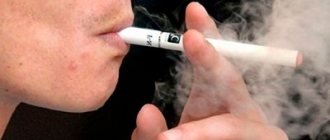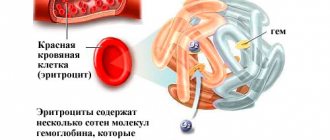Diseases that high hemoglobin may indicate
The causes of increased hemoglobin levels, so-called internal factors, may be the following diseases:
- Diabetes.
- Bone marrow diseases.
- Heart and kidney diseases, burns, stress, dehydration (in these cases, erythrocytosis occurs due to lack of oxygen in the organs).
- Cholelithiasis.
- Diseases of the gastrointestinal tract.
- Oncological diseases.
- Allergic reactions.
- Lung diseases - pneumonia, bronchitis, emphysema, bronchial asthma and others.
- Chronic hypoxia.
- Genetic predisposition.
- In newborns, an increase in hemoglobin levels above normal can be caused by intrauterine hypoxia, as well as by transfusion of donor or placental blood.
Lose weight on tobacco?
Smoking in general causes your metabolism to speed up. The body spends energy more actively and burns reserves. Therefore, yes, of course, you can lose weight with cigarettes. But is the result worth it? “Weight loss from tobacco is of the same nature as weight loss from cancer
or from improper functioning of the thyroid gland,” says Galina Sakharova, Doctor of Medical Sciences, Deputy Director of the Research Institute of Pulmonology of the Federal Medical and Biological Agency of Russia. “A smoker loses weight because the body is trying to cope with the negative consequences of smoking.”
Why quit smoking?
You have given up smoking. What will happen tomorrow, in two weeks and in a few months? Only good.
High hemoglobin levels not associated with disease
If the hemoglobin level is elevated, this does not necessarily indicate disease or pathology in the body. This may be due to external factors:
- In people living in high altitude areas, low oxygen levels force the body to produce more hemoglobin.
- Men and women who fly on airplanes more often than others - pilots and flight attendants - may also have higher hemoglobin, which in their case will be considered normal.
- Hemoglobin levels are increased in athletes involved in heavy, active sports, such as triathlon, mountaineering, skiing and speed skating.
- An increase in hemoglobin may also occur when taking anabolic steroids.
- One of the factors influencing the increase in hemoglobin in the blood is active smoking.
The mechanism of development of nicotine addiction
Usually, addiction to tobacco begins in adolescence and is mistaken for some kind of self-indulgence.
However, this bad habit very quickly develops into addiction. First, of course, psychological, since for any smoker the process of smoking becomes a method of communication with other people, a means of distraction, concentration, etc. Most addicted people associate smoking with different situations - be it a break at work, waking up with a cup of coffee and a cigarette, waiting for transport, meeting and relaxing with friends, excitement before various events. Smoking becomes a powerful ritual, formed over the years, which can be very, very difficult to destroy (I’ll immediately explain that this is self-deception and self-hypnosis; it’s just as easy to walk 5 circles around the house), and then into the physical. In people, the self-defense function does not work, which should warn us from everything that can harm, because, subjectively, there is no direct and quick negative effect on the body. And even more so, no one immediately thinks about the effect of nicotine on the brain. However, it is very large. The formation of physical dependence on tobacco occurs with the participation of the central nervous system. The main substance that transmits impulses between the nuclei and cells of the central nervous system is the neurotransmitter dopamine. If a lot of dopamine is released, a person experiences pleasure, and when the amount of dopamine drops, he experiences withdrawal symptoms. After 7-10 seconds of smoking, nicotine enters the brain. After initial consumption, nicotine increases dopamine transmission, giving a pleasant sensation and causing addiction. Regular smoking changes the dopamine transmission complex, nicotine becomes part of this complex, that is, without this substance, dopamine transmission will not be normal. There is a strong craving for smoking, or nicotine addiction.
Smoking and hemoglobin
Smokers often have elevated hemoglobin levels. There is no scientific explanation for this yet, but scientists suggest that the increase in hemoglobin is the body’s defense mechanism when the oxygen content in the lungs is low. In their opinion, these mechanisms operate by analogy with the processes of the inhabitants of the highlands.
Sometimes smoking can hide a person's existing iron deficiency anemia. In these cases, the natural level of hemoglobin in a person is low, but with active smoking it artificially rises to normal levels, and the lack of iron in the body cannot be recognized in time.
The influence of tobacco smoking on the composition of human blood...
It's no secret that smoking has a detrimental effect on human health, but few people know that a smoked cigarette affects not only your lungs: many other body systems also suffer. Let us consider in more detail how smoking affects the rheological properties of blood, that is, its viscosity and ability to clot.
You may ask: “But, actually, what difference does it make how it is rolled up?” However, not everything is so simple - damage to a smoker’s blood coagulation system is no less dangerous for his health than the toxic effect of tobacco smoke on the mucous membrane of his respiratory tract, which can lead to the development of cancer. At first glance, it may seem unclear how a smoked cigarette can affect blood viscosity?
Let's figure it out. As you probably know, this smoke contains about 4,000 different substances besides nicotine, and many of them are far from harmless to our health. To understand what happens to blood viscosity in a smoker, you need to briefly talk about how the blood coagulation system works. The ability of blood to change its viscosity is extremely important for the normal functioning of our body; the most striking example of its necessity, of course, is the formation of blood clots, when blood, under the influence of coagulation systems, changes its density, blocking a damaged vessel and stopping blood loss. The coagulation system, figuratively, is a scale, on one pan of which there are mechanisms that increase its viscosity, and on the other - those that increase its fluidity.
This system is in a constantly changing equilibrium, depending on the current situation, viscosity or fluidity predominates. However, all this is disrupted when a person starts smoking. If we return to the scale analogy, the cigarette reduces the cup, which increases the fluidity of the blood. Nicotine and tobacco combustion products lead to disruption of the functioning of anticoagulant (anti-clotting) blood systems, the blood becomes more viscous, prone to forming blood clots. Many will say: “So what, good blood clotting is good - the cuts will heal better.” This point of view is wrong. The fact is that an increase in blood viscosity occurs throughout the body and leads to the fact that in small vessels the blood begins to flow more slowly, and, accordingly, the thrombus formation mechanism begins to spontaneously start there. Many small blood clots begin to plug the lumens of the blood vessels, and the smoker’s internal organs begin to suffer from a lack of oxygen and nutrients supplied by the blood. Of course, the body tries to fight this, opens additional blood supply routes, removes blood clots with the help of phagocytes, but its powers are not limitless; after a few years of such an attitude towards oneself, the smoker is surprised to learn that he is beginning to develop polyneuropathy, signs of angina pectoris have appeared, and the kidneys no longer work as they should.
It should also be noted that due to constant oxygen starvation in the blood of smokers (as a protective reaction of the body), an increased number of erythrocytes (red blood cells that carry oxygen) are formed, which also makes the blood more dense and viscous.
Increased blood viscosity leads to poor circulation in all organs and tissues, which can lead to serious illnesses. The risk of myocardial infarction and stroke increases significantly.
The insidiousness of this pathology lies in the fact that a person does not feel anything until it is too late and irreversible changes occur in his body. Increased blood viscosity becomes more dangerous in the presence of atherosclerotic changes in blood vessels.
P/sanitary doctor of the branch of the FBUZ "Center for Hygiene and Epidemiology in the Ryazan Region in the Shilovsky District" Nadezhda Koldaeva
More details
Laboratory diagnostics
Smoking and hemoglobin are inextricably interconnected; its level in the blood depends on the length of time the smoker has been smoking and the strength of the cigarettes. If you lead an unhealthy lifestyle, you need to periodically visit a therapist, he will give a referral for laboratory diagnosis of diabetes to a person with a violation of the level of nicotine in the blood.
The norm is:
- 130–170 g/l in men;
- 115 – 155 g/l in women.
A complete blood count in a laboratory test will show the level of the component in the blood. If it does not meet the norm, the doctor will prescribe a special therapeutic diet.
Tobacco is stronger than marijuana
Comparative studies have shown that tobacco causes physiological dependence more than caffeine and marijuana, “losing” to alcohol, heroin and cocaine. As for psychological addiction, it is ahead of everyone, including heroin and cocaine. This is because nicotine increases the level of dopamine (also called the pleasure hormone) in the brain and, at the same time, smoking suppresses monoamine oxidase, a special enzyme that breaks down dopamine. The brain receives pleasure signals, but quickly gets used to the increased pleasure. Over time, the dose is required more and more, but the pleasure becomes less and less
. A drug is a drug.
About a dead horse
“A drop of nicotine kills a horse” - words familiar from childhood, and so hackneyed that they are perceived ironically. Moreover, a drop of nicotine (let’s say 0.05 milliliters) is a lethal dose for an adult
(respiratory and cardiac arrest).
The smoker consumes a nerve poison every day, and quite a strong one. It was not in vain that it was used as an insecticide. A smoker can call 8-800-200-0-200
(the call is free for residents of Russia), say that he needs help quitting smoking, and he will be switched to specialists at the Advisory Call Center for Help in Quitting Tobacco Consumption (CTC) . If all KTC specialists are busy at this moment, his phone number will be sent to KTC by e-mail, and they will call him back within 1-3 days. Psychologists and doctors provide counseling to those who contact the CTC. Psychologists help prepare for the day of quitting smoking, help find a replacement for smoking rituals, together with the client they will determine the optimal ways to overcome addiction, and support in difficult moments in the fight against nicotine addiction. Doctors will advise on the most effective therapeutic methods for quitting smoking, and give advice to patients with various diseases on how best to prepare for quitting smoking, taking into account existing health problems.
Tags:
- Smoking
- Lifespan
- Metabolism
- Cancer
• To leave a comment you must be an authorized user
- cipocola I have been smoking for 8 years. I was pregnant and smoked (stupid), when my son was born, I didn’t smoke for 2 months, then I stopped breastfeeding and it all started again. Smoking, smoking, smoking. Moreover, they say that smoking provokes a relapse of psoriasis, so I’ll go now and break all the cigarettes, don’t mind.....
- rckstr I haven’t smoked for almost 3 years) It’s really easy to quit if you don’t get hung up on the thought that you’re quitting and don’t think about it. Do it and forget it!
- KaZantipchik Yesssssssssssss....I haven’t heard about radioactivity) It’s worth thinking about...
- SergeyWilson ABOUT CANCER!!! In fact, no one has proven this yet! The nature of cancer has not yet been established. (THE PERSON WHO REVEALED THE MYSTERY OF CANCER WILL RECEIVE A NOBEL PRIZE) The same scientists 60 years ago believed that tuberculosis appears from smoking, as a result of which cigarettes were no longer sold in more than half of the American states. As a result, the research was almost completely stopped of this disease. And people died from tuberculosis despite the measures introduced by Scientists (ban on the sale of tobacco)
- Helga_Sparks makcum25, how can we get rid of the fear that we won’t be able to live without a cigarette?
- makcum25 In fact, it’s very easy to quit smoking! I smoked for 10 years and then quit this crap. We just need to get rid of the fear that we won’t be able to live without a cigarette.
- otragenie Great article, thanks! This kind of information is sorely lacking, what and how it works.. It would also be great to read statistics on mortality from diseases caused by smoking in Russia and the world. Thank you!
- tosya-kislicina I always try to quit smoking and drinking when the next Lent begins. It’s easier for me psychologically, because... Many people limit themselves in many ways during this period. True, I was missing for more than a week. I hope it will work out now))). I wish everyone willpower in this matter!
- I support Himikus. it's actually easy, I was surprised myself
- alexandervulfert needs to stop poisoning yourself and those around you ONCE and FOR ALL!!! it's very easy to do!
- Egypt needs to quit smoking more often)))
- neloser and me )))))
- in-chik I will read this article more often!
How does smoking affect blood test results?
If you detect an increased level of hemoglobin and a high number of red blood cells, you must tell your doctor that you smoke. If this is not done, the prescribed drug treatment will not be effective, since it will be aimed at eliminating problems without the influence of nicotine.
When smoking, the following processes occur in the blood in the body:
- Iron levels drop;
- cholesterol indicator is distorted;
- glucose levels become higher;
- the number of red blood cells increases moderately.
When undergoing preventive examinations, you need to quit smoking so that the clinical picture is not distorted, and treatment is prescribed in accordance with your diseases, and not those indicated due to a bad habit.
Difficulties in making a diagnosis in smokers
Smoking often causes iron deficiency anemia to occur in a latent form. It is difficult to diagnose in the early stages, since nicotine affects the composition of the blood. It increases its amount, but at the same time the transfer of oxygen into cells decreases. The doctor must ask if you smoke in order to do the analysis accurately.
Toxic substances in tobacco change the composition of the blood, reducing the concentration of red blood cells. This causes misdiagnosis, since their levels stabilize after smoking cessation.
On a note! Just 3 days after you quit smoking, your blood tests normally improve by 70%.










